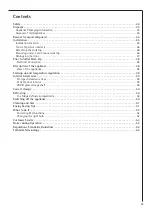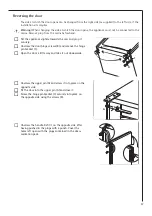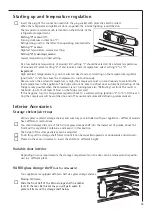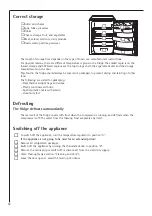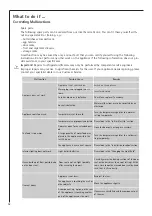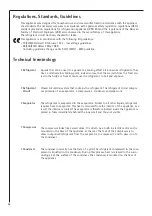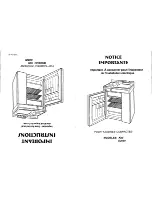
Disposal
Appliance Packaging Information
All materials are environmentally friendly. They can be dumped or burned at an incinerating plant with-
out danger.
About the materials: The plastics can be recycled and are identified as follows:
>PE< for polyethylene, e.g. the outer covering and the bags in the interior.
>PS< for polystyrene foam, e.g. the pads, which are all free of chlorofluorocarbon.
The carton parts are made from recycled paper and should be disposed of at a waste-paper recycling col-
lection location.
Disposal of old Appliances
For environmental reasons, refrigeration appliances must be disposed of properly. This applies to your old
appliance, and - at the end of its service life - for your new appliance as well.
Warning!
Before disposing of old appliances make them inoperable. Remove plug from mains, sever the
power cable, remove or destroy any snap or latch closures. This eliminates the danger that playing chil-
dren lock themselves into the appliance (danger of suffocation!) or place themselves into other life-
endangering situations.
Disposal:
• The appliance may not be disposed of with domestic waste or bulky refuse.
• The refrigerant circuit, especially the heat exchanger at the back of the appliance, must not be dam-
aged.
• Information concerning collection schedules or locations can be obtained from your local Council or
Environmental Health Office.
Remove transport safeguard
The appliance and the interior fittings are protected for transport.
Pull off the adhesive tape on the left and right side of the door.
You can remove any remnants of adhesive using white spirit.
Remove all adhesive tape and packing pieces from the interior of the appliance.
☞
☞
45
Installation
Installation Location
The appliance should be set up in a well ventilated, dry room.
Energy use and efficient performance of the appliance is affected by the ambient temperature.
The appliance should therefore
– not be exposed to direct sunlight;
– not be installed next to radiators, cookers or other sources of heat;
– only be installed at a location whose ambient temperature
corresponds to the climate classification, for which the appliance is designed.
The climate classification can be found on the rating plate, which is located at the left on the inside of
the appliance.
The following table shows which ambient temperature is correct for each climate classification:
Climate classification
for an ambient temperature of
SN
+10 to +32 °C
N
+16 to +32 °C
ST
+18 to +38 °C
T
+18 to +43 °C



